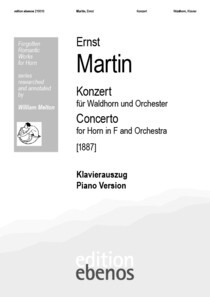Konzert
für Horn und Klavier
 ebenos musik verlagStil:
ebenos musik verlagStil:  MusicalAusgabe: NotenArt-Nr.: K22863 / EE 210010 Level:
MusicalAusgabe: NotenArt-Nr.: K22863 / EE 210010 Level:
Sondershausen is a town in Thuringia that for centuries was distinguished by the residence of the Princes of Schwarzburg-Sondershausen. Despite the towns modest size (pop. 7,759 in 1910), a court orchestra had existed since 1637. In the early 19th century the groups public Loh Concerts originated on the princely estate (near the Loh, a local term for the forest park). The orchestra attracted some formidable musical talent: Max Bruch was Court Kapellmeister until 1870, and Franz Liszt would write the following year,
The ensemble, conducted by [Max von] Erdmannsdörfer, belongs to the most famous in Germany, and quite rightly. Nowhere else is the orchestral literature performed with more understanding, precision and verve. It is a wonder that it is hidden away in such a tiny place.
In 1883 a music conservatory was established in Sondershausen. It quickly became known as a bucolic alternative to the massive Leipzig Conservatory. The faculty would include musicologists Hugo Riemann and Philipp Spitta, and the young Max Reger attended classes for a time. Kammermusiker Ernst Martin, a first desk violinist in the orchestra, was engaged as professor of violin and viola and schooled a generation of pupils, including a certain Oscar G. Sonneck of New Jersey.* His facility as a composer led Martin to produce a tidy catalog of compositions that encompassed orchestral, piano and chamber works. Of interest to hornists, he composed a woodwind quintet and horn duets and trios, as well as that exceedingly rare creation a high Romantic concerto for horn and orchestra.
Martins Concert in F Dur für Waldhorn mit Orchester- oder Pianofortebegleitung was published in Dresden by J. C. Seeling about 1887 (Plate Number 1085) and Dedicated to Herr Kammermusikus [Gustav] Bauer in Sondershausen. A fellow teacher at the conservatory, Bauer was a gifted hornist who had left a more prominent post in order to play in the smaller city. He presided over a fine section: the young Xaver Reiter, later a celebrated virtuoso in the U.S., played under Bauer in Sondershausen for three seasons. The piece that Bauer inspired is lengthy and through-composed like the first concerto of Richard Strauss that debuted in nearby Meiningen in 1885, and features an ambitious, if conventional, Allegro moderato, a sweetly lyrical Adagio, and an Allegretto finale that delivers the kind of pyrotechnics that audiences crave (featuring both top and bottom concert Fs). The work was a fixture on Professor Bauers horn studio syllabus before the turn of the century while Richard Strauss concerto was omitted.





